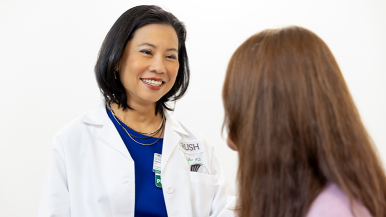Colorectal cancer is the third most common cancer in the United States and the second most common cause of cancer death for Americans, in large part because it can grow for some time without causing any symptoms.
The earlier colorectal cancer is detected, the better the options for successful treatment, says Salina Lee, MD, a gastroenterologist at RUSH MD Anderson Cancer Center.
These days, the prep is easier
Lee says that colonoscopy — looking at the colon with a special tool called an endoscope — remains the gold standard for colorectal cancer screening. “We’re able to see directly inside the colon, so our chances of missing colon cancer are going to be much lower,” than with many at-home tests, she explains.
“We’re also able to detect and remove precancerous lesions called adenomatous polyps, or adenomas. If we can remove a polyp during a colonoscopy, we can potentially prevent a cancer from ever happening.”
So, what stops people from getting this gold-standard screening? People hate the traditional pre-procedure prep to empty the colon, which allows the gastroenterologist to get a good view, Lee says.
'People’s ideas about the prep are one of the biggest barriers that prevents them from ever coming through my door.'
But Lee wants you to know that there’s a good chance your knowledge of bowel prep is outdated. “The standard used to be that you’d clean out your bowels for a whole day or more by drinking a large volume of a foul-tasting liquid, and you’d have to be without meals for days on end,” she says.
But these days, the prep is far easier. “The prep is split into two doses, and there are much smaller-volume, better-tasting options available — as small as two six-ounce doses,” Lee says. “In addition to small-volume liquids, there are also tablets available for those who are averse to taking liquid medication.”
You start the bowel prep the day before your colonoscopy and can eat a low-fiber diet (no nuts or seeds, beans, whole grains or high-fiber vegetables) until noon. After that, until midnight, you can have any clear, non-red liquid, including freezer pops or gelatin.
Prep options evolve rapidly. Lee recommends asking your physician about what bowel prep options are available when you schedule your procedure.
Technology keeps improving
While high-quality bowel prep is the best aid for helping gastroenterologists detect adenomatous polyps during colonoscopy, advances in technology are also increasing detection rates.
- Virtual chromoendoscopy is a high-contrast imaging tool. “With the click of a button, I’m able to change my scope so it’s looking at the colon with a different contrast,” Lee says. “If there’s an adenoma, it will be highlighted.”
- Endoscope attachments help the gastroenterologist get a better look at parts of the colon that are folded or curved. These tools straighten and flatten the tissue so that no part of the colon is hidden.
- AI-assisted colonoscopy uses novel artificial intelligence to improve the detection of adenomas. This technology identifies and highlights areas for the gastroenterologist to examine especially closely. Rush University Medical Center was the first in Illinois to make this technology a standard tool in every colonoscopy.
Ask your provider about screening
It’s recommend that everyone with an average risk for colorectal cancer should begin screening at age 45. Talk with your doctor to help you decide if screening is needed after age 75. It is not recommended to screen after age 85. If you’re at an increased risk because of your family or personal medical history, talk to your doctor about individualized screening guidelines.




